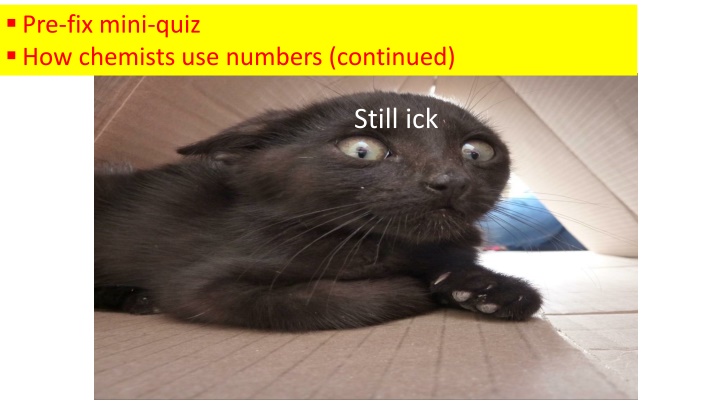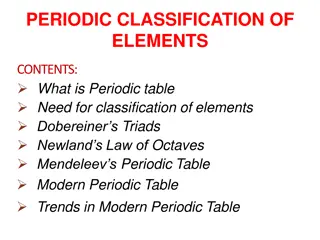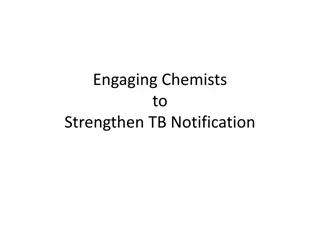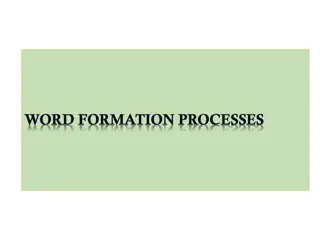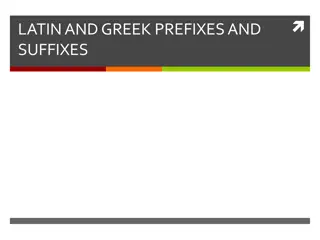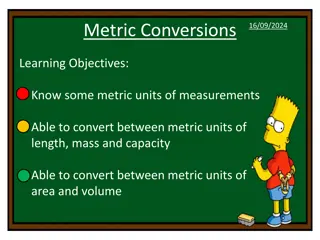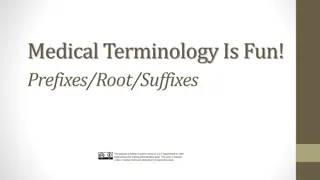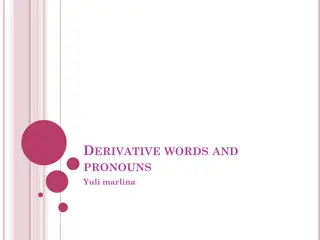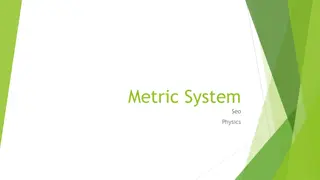How Chemists Use Prefixes and Unit Conversions
Use of prefixes in chemistry and learn how to convert between different unit systems efficiently. Discover the essential techniques in metric system conversions, scientific notation, and common prefix units.
Download Presentation

Please find below an Image/Link to download the presentation.
The content on the website is provided AS IS for your information and personal use only. It may not be sold, licensed, or shared on other websites without obtaining consent from the author.If you encounter any issues during the download, it is possible that the publisher has removed the file from their server.
You are allowed to download the files provided on this website for personal or commercial use, subject to the condition that they are used lawfully. All files are the property of their respective owners.
The content on the website is provided AS IS for your information and personal use only. It may not be sold, licensed, or shared on other websites without obtaining consent from the author.
E N D
Presentation Transcript
Pre-fix mini-quiz How chemists use numbers (continued) Still ick
So far: Metric system (MKS) Scientific notation prefixes
(Unfortunately) there are many competing choices of prefixes for a given quantity in chemistry (and physics and biology) How do I convert between these %%&! prefix systems ? EXAMPLE Common prefix units used to define wavelength, : m nm pm m m (millimicron) =10-1 nm
2 ways to convert between metric units 2 ways to convert between metric units 1) Algebraic ( Marine way) Doc s story about his HS chem teacher Divide and conquer, maggot !
2 ways to convert between metric units 2 ways to convert between metric units 1) Algebraic ( Marine way) Doc s story about his HS chem teacher Divide and conquer, maggot !
2) Factor-label (commonly taught by high school teachers) Major stumbling block for many students
15 m = ??? pm Done two ways on blackboard
Guided practice Unit conversions answers 4.57*104 g Convert 45.7 kg to g Convert 0.73 mL to L 730 L =7.3*102 L Convert 100 ps to ns 100 ps =0.1 ns Convert 7.2 kg/L to mg/ L 7.2 mg/ L
Convert 100 pm to nm A. 0.01 nm B. 0.001 nm C. 1 nm D. 0.1 nm E. No clue help ! 20% 20% 20% 20% 20% 0.1 nm 1 nm 0.01 nm 0.001 nm No clue help !
Convert 5000 kg to Mg A. 5 Mg B. 50 Mg C. 0.5 Mg D. 500 Mg E. Still no clue need nap 20% 20% 20% 20% 20% 5 Mg 0.5 Mg 50 Mg 500 Mg Still no clue need nap
PRECISION AND ACCURACY : what are they ? Your thoughts ..
Why do we care about Sig Figs in Chemistry? The Sig Fig count tells us the precision of measurement 1 sig fig How long is the screw ? 5 cm 2 sig fig How long is the screw now? 5.1 cm
Metric micrometer does even better https://encrypted-tbn2.gstatic.com/images?q=tbn:ANd9GcRu9WN1XxxcSOTsTy-DltBINC5f_qxjtpTZ1oDPoSYOHFtu_Bhm 51.03mm How long is the screw now in cm ? 5.103 cm 4 sig fig How many sig figs now ?
Technological aside: Higher verifiable precision (more sig figs) correlates with higher technical development 2016: we can pin point the position of anyone via GPS to within ~ + 0.0001 miles (within 12 inches) 1492: Columbus is within + 10,000 miles of estimate for Earth s diameter In ~ 500 years human measurement precision has increased by > 10 million
Counting sig figs Counting sig figs: : Atlantic Atlantic & & Pacific Pacific method method Absent Decimal move from right (Atlantic side) and start counting when first non- zero digit encountered 10020 300 450070 4 1 5 # sig fig ?
Counting sig figs Counting sig figs: : Atlantic Atlantic & & Pacific Pacific method method Possesses decimal move from left (Pacific side) and start counting when first non-zero digit encountered 4 2 3 1.002 0.030 0.00400 # sig fig ?
What is the sig fig count given a scientific notation version of a number ??? 3 sig figs exponent Example: 6.02*1023 Pre-exponent The count of digits in the pre-exponent is the sig fig count.
# sig figs ? value 0.0051 510 5.10 5.0010 5.0*1060 # sig figs = 2 2 3 5 2
Calculations done to correct sig fig Adding/subtracting The decimal count of the least precise value sets the determines the calculation s decimal count . 3.1 3.001 + 0.1 + 0.01 =_____ 16 14.5- 0.100 + 2 = _____
1.00+50.1+ 0.100= A.51.200 B. 51 C. 51.2 D.51.20 25% 25% 25% 25% 51 51.2 51.2 51.2
400 + 2.0 -1.999 +0.03= ? A.400 B.400.03 C.400.0 D.400.031 25% 25% 25% 25% 400 400 400.03 400.031
Calculations done to correct sig fig (cont.) Multiplying/dividing The value with the lowest sig fig count dictates the calculation s sig fig count 9 11*0.9 5.1000*0.211 =_____ 1.0 (10.1/2.000) =______ 5.0*0.99876
Calculations done to correct sig fig (continued) Combos of Multiplying/dividing with adding/subtracting Do +/- first to correct count; then x and / to lowest sig fig count 3.1 3.00 3.001 + 0.1 + 0.01 = _______ 1.5000*2.00 = 1.0
